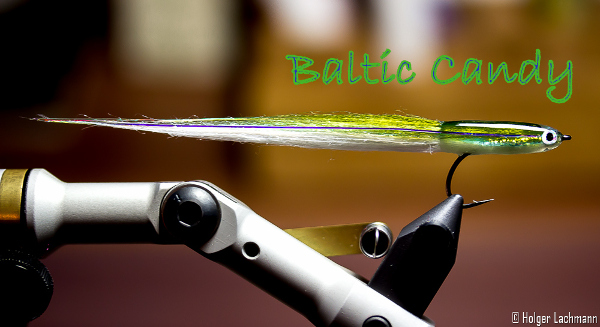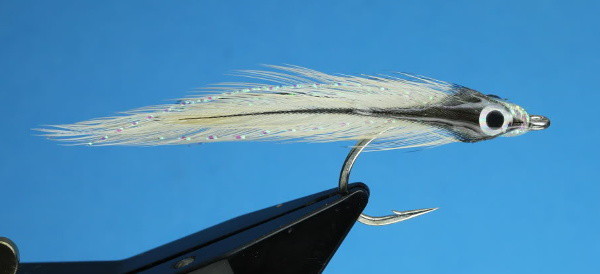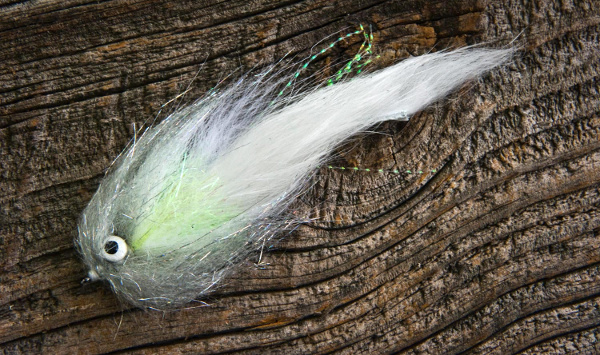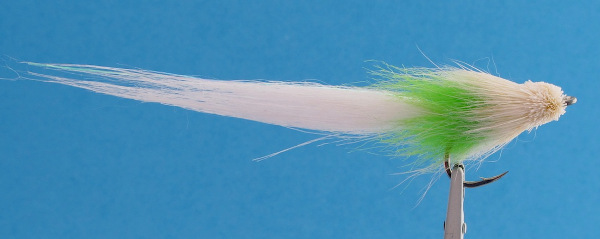
Looking for some new striped bass flies to fill your fly box? Many striped bass anglers have clousers, deceivers, flatwings, Tarbory snake flies, or some variation of these flies in their fly box. I’ve put together a collection of some striped bass patterns that will hopefully vary from the usual suggestions. Hopefully you discover a new pattern on this list to help you with your striped bass fly fishing.
Baltic Candy

The Baltic Candy is Holder Lachmann’s take on the well know Surf Candy Fly. He has an excellent step by step tutorial. The primary difference is that he uses Polar Fibre for the fly, which gives it more movement than a traditional Surf Candy.
Steve Farrer’s Flounder Pattern

This is an amazing flounder pattern great for shallow water, such as surf casting. The fly uses a neat trick to make the hook ride right side up. The fly uses a mix of epozy and tungton powder applied to the bottom of the fly to make the bottom half heavy. You can see this epoxy/powder mixture If you take a look at the fly that’s upside down at the top of the picture above. Source page is Stripersandtrout.blogspot.ca. The flie in the middle is tied in a similar manner, but since the hook is orientated differently it’s a good bunker or sunfish imitation.
Badger Hackle Streamer

This is a really simple, but really cool little streamer pattern. It just consists of two hackle feather’s on either side of the hook, some flash, eyes, and either epoxy or UV cure resin. The pattern doesn’t even use thread! This pattern, and other similar patterns can be found sexyloops.co.uk.
Crease Fly

Crease flies are unique flies that consist of foam folded over the hook shank. They are similar to poppers in that they are both surface flies, but crease flies have their own unique action. The taller body shape also helps them more closely match tall bodied forage fish such as many herring species. The pic above came from stripersonline.com’s forums.
If you buy anything below, i get a bit of beer money (commission).
Flex Tail Minnow

This fly uses an “extended body” to provide a flexible tail. The tail is made out of two good biots, which are tied onto either flash material or stretch floss. It’s a very unique pattern and the flexible tail provides plenty of movement. There’s a good tutorial on how to tie it over at acreativeflytyingblog.blogspot.ca.
Dan Blanton’s Whistler Fly

This is a old West Coast Pattern, and it’s name comes from the whistling noise the eye’s make when casting. Image source is from the American Museum of Fly Fishing. It’s was tied with the intention of mimicking the bucktail jigs used by spin fishermen in the area. Large bucktail flies in general are typically a great choice for stripers
Matt Grobert’s Cinder Worm

This is a pattern I discovered through watching the Tightlinevideo on YouTube. It’s a very good imitation of an actual cinder worm, and the deer hair head keeps it near the surface, just like the real thing.
The Betsy

The Betsy is a great little striper fly created by a guy that goes by “Bonefish Dick”. There is an excellent post over at Ginclear.blogspot.ca about the history of the fly, and gives good instructions on how to tie this fly. The author of the post over at Gin Clear states it’s his go to striper pattern, and I gotta say it does look good!
E-Z Sand Eel

Sand eels are a primary forage food for striped bass. This E-Z sand eel pattern does an excellent job of matching a sand eels profile, while providing plenty of flash to catch stripers attention. A great tying tutorial can be found at thefeatherbender.com.
Garners White Trash

The very large head on this fly is going to push alot of water, and would be excellent in muddy water. There is a great video showing how to tie one of these over at GinkandGasloline.com.
The Triple Roamer

The Triple Roamer is a pattern from allthingsflyfishing.blogspot.ca/. This is another fly with a large head that will push alot of water, this and it’s thick profile would make it a good choice for estuaries and other water with low visibility.
GnG Hollow Rattling Baitfish

This is a very lightweight and hollow pattern tied by Dron Lee over at Fly Tying Nation. The goal of this pattern was to use as few materials as possible to create a lightweight fly that casts well and moves freely through the water.
Striper Slider

The striper slider has a nice long profile. I’ve tied a few of these up since the profile is quite close to smelt, and I think it’ll be a good fly for when the smelt are around.
A few of my own.
I’ve tied a few striped bass flies up inspired by the Tarbory snake fly. I don’t have ostrich herl so I had to improvise, and since I was improvising I made a few other changes as well. The flies consist of a spun deer hair head, dumbbell eyes (painted when I think of it), a very thin deer hair collar, schapplen mid section, marabou rear, flash of choice, and used either a bunny strip or a deceiver style saddle hackle tail. I also have a bunch of poppers tied up in preparation of striped bass season.




Awesome patterns, all would be great for strip bass, but don’t overlook the power these patterns would have on the spots and smallmouth—thanks for sharing
I could absolutely see these patterns working for smallies and other bass as well. Thanks for the comment.
This is a great post! Thanks for sharing the Betsy Fly here. I need to tie up some of these other excellent striper patterns.
No problem, it looks like a fantastic fly.
Thanks for the inspiration Ben. Good to see a few of your own ties.
Thanks, I was concerned about posting them along side all these other great patterns but I think it worked out.
Ben, I don’t know beans about what makes a great bass fly but I do know what I like. I can actually see a few of those hooking a big angry brown.
O no doubt, I’ve heard Browns like big meaty flies. We only have a few transitional brown’s here that wander over to our island from the mainland, mostly brookies and rainbows for trout here.
That striper slider is from Saltwaterflies.com. I can tell you it’s a solid fly for stripers in many different situations.
I’ve caught a few midsized stripers on that fly. The fly looks great in in the water
Nice collection of striper patterns some of which I will definitely tie next Winter.
I tied a few Garners White Trash flies this Winter and tried them out this Spring. They quickly turned into White Trash hairballs which require a toothbrush or small wire brush to comb out every third or fourth cast. The weighted eye and all that synthetic bulk and rabbit strip which holds lots of water make casting this beast any distance a risky maneuver. All in all, this is a heavy, overdressed, high maintenance fly that has not been very effective yet. I think the best place to use it is with short casts into a school of peanut bunker that is under direct attack by feeding stripers.
Just what I was looking for.